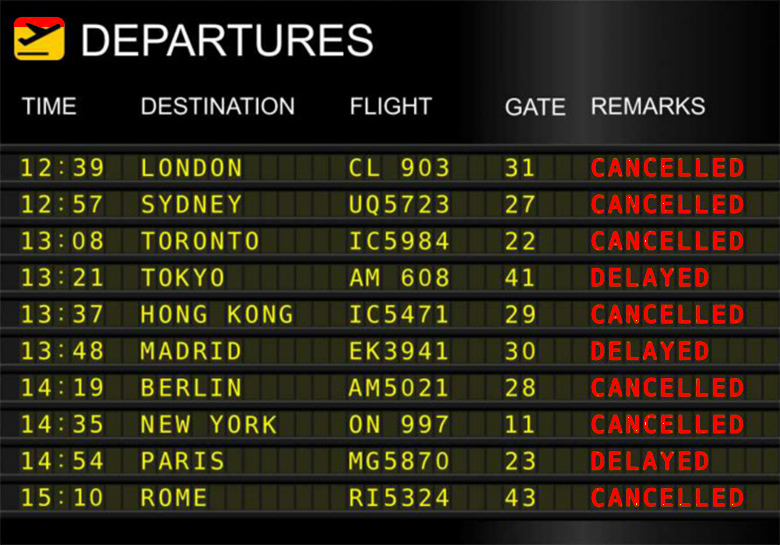When you regularly follow the latest in technology and modern innovations, there comes a moment when the thought arises that we have been living in a cyberpunk era for quite some time, albeit without mutants and flying cars. However, every modern device is a complex combination of hardware and software components, consisting of thousands or even hundreds of thousands of lines of code.
One only makes no mistakes who does nothing, so generally, any software code contains a certain number of errors that may even make their way into the final product despite meticulous multilevel testing. While some errors may simply cause your smartphone to freeze at the most inconvenient moment, others, like the ones outlined below, can lead to incredible financial losses, disruption, and fatal consequences.
Heathrow Airport Baggage Chaos
Travel is always stressful, albeit usually positive. But there are unpleasant exceptions. In the spring of 2008, Terminal 5 was introduced at Heathrow Airport, but the event was overshadowed by a massive failure in the baggage processing and transportation system.
As it turned out, the software was not quite perfect, and no issues were encountered during test launches and trials. However, under high loads in real conditions, the system failed, causing real chaos on the baggage belts. In total, the problem affected over 42,000 pieces of luggage, leading to the cancellation of more than 500 flights in the first ten days. The malfunction cost British Airways over £16 million.
Tesla Car Software Bugs
Electric cars are becoming increasingly popular, and with that, the problems they cause are growing. In 2021, Tesla had to recall over 12,000 vehicles due to bugs in the beta version of the autopilot software. Due to errors in the beta version of the 10.3 Full-Self Driving (FSD) software, the cars behaved incorrectly on the road.
During a thorough investigation, a communication error was discovered in the beta version of the software. The error could trigger a false warning of a frontal collision, activating the Automatic Emergency Braking (AEB) system. This, in turn, increased the risk of injury to the driver and Tesla passengers and could lead to rear-end collisions. Fortunately, there were no reports of accidents caused by this issue.
Southwest Airlines Fiasco

Photo: Cancelled flights, Source: Telegram
In late 2022, the Christmas and New Year period in the United States was marked by extremely challenging weather conditions. This created peak loads for carriers, as people usually travel or visit relatives during the holidays. Overall, airlines coped well with the challenge, except for Southwest Airlines, which ranked third in domestic passenger volume.
The company’s software turned out to be so imperfect that it led to the cancellation of over 15,000 flights. The system simply could not process such a significant volume of data, taking into account the numerous constantly changing factors. However, the main cause was still human – the company’s management did not pay proper attention to software development issues. As a result, the company suffered losses amounting to over $220 million and tarnished its reputation, ruining holiday plans for its customers.
NASA Mars Climate Orbiter Crash
The aerospace industry is rich in incidents caused by errors in calculations and software. One of the most illustrative and costly incidents involved a weather probe that NASA intended to send to Mars in 1998. The spacecraft, costing over $125 million, successfully launched and followed the prescribed course for about nine months. However, during atmospheric entry, communication with the probe was lost, and it disintegrated in the Martian atmosphere due to overload.

Photo: Mars Climate Orbiter, Source: NASA
Test results and simulations were flawless, but the catastrophe indicated an error’s presence. The investigation revealed the cause: a miscalculation due to different measurement systems. NASA used the imperial system, while the company that created the control module software used the metric system. As a result, the probe entered the atmosphere at too high a speed, leading to its destruction. The total financial loss associated with the mission failure exceeded $320 million.
False Routes in Apple Maps
One of Apple’s biggest failures occurred in 2012 when the company decided to abandon Google Maps’ service and mapping data in favor of its own mapping application, which Apple created itself. What exactly went wrong is unlikely to ever be known. Still, Apple Maps provided users with incorrect and inaccurate data. Various objects such as bridges, lakes, stations, and stops were either missing from the maps or incorrectly marked, misleading users during navigation. The situation was so dire that Tim Cook apologized for the service, albeit somewhat belatedly. Overall, the troubles with Apple Maps cost the company approximately $30 billion.
Boeing 737 MAX Disaster

Photo: Boeing 737 Max, Source: Wiki
When business sharks try to effectively combine their own ambitions with the interests of investors and shareholders without delving into the intricacies and the essence of the matter, disaster is inevitable. The Boeing 737 MAX aircraft was supposed to be an efficient response to competition from Airbus. However, fewer engineers than needed worked on the modernization of the aircraft.
Most processes were carried out by contractors and subcontractors, and outsourcing companies created the software. Thanks to larger and more powerful engines, the aircraft could accommodate more passengers, fly farther, and consume less fuel. However, these engines caused maneuvering complications – the aircraft’s nose constantly pitched up. The problem was intended to be solved programmatically through the MCAS system, which would autonomously adjust the aircraft’s position in the air.
To save on pilot retraining, information about MCAS was almost absent. The system received data from a single sensor, which, as it turned out, could provide false readings. As a result, the aircraft immediately nosedived. Pilots had no chance against the deadly software. The result was predictably fatal: the crash of Lion Air flight 610 and later the Ethiopian Airlines plane, claiming 346 lives.
***
These stories mentioned here are just a drop in the ocean. Catastrophes caused by software glitches are far more numerous, and their list goes deep into the 20th century – from the 1987 Wall Street Black Monday and the miscalculation of a CAD (Computer-Aided Design) programmer that led to the instantaneous collapse of the steel roof of the Hartford Civic Center in 1978 to the largest non-nuclear explosion on the Trans-Siberian gas pipeline in 1982 and the Dot-com bubble in 2000.
Optimists like Sam Altman believe that advanced artificial intelligence, like the mysterious Q* created by the folks at OpenAI, can minimize such computer failures if given the necessary authority.
Hmm… Here, one cannot help but mention the Skynet computer network, also created as a panacea for various issues and bugs in defense software but unexpectedly decided that humanity was the main problem.
We have no reason to think that the infamous Q* will behave the same way.
However, we also have no reason to think that it won’t.
Source: The Gaze







